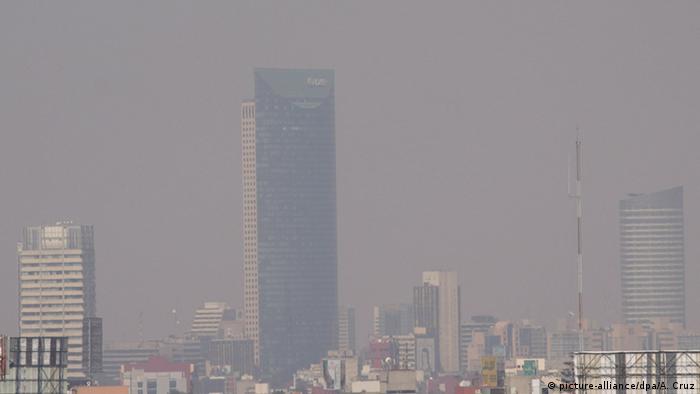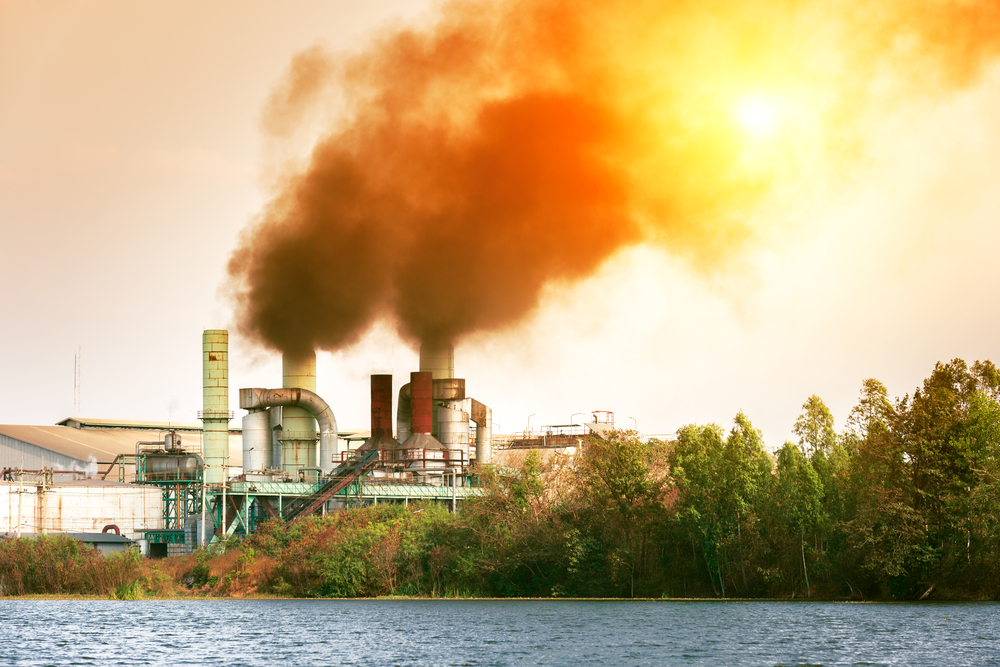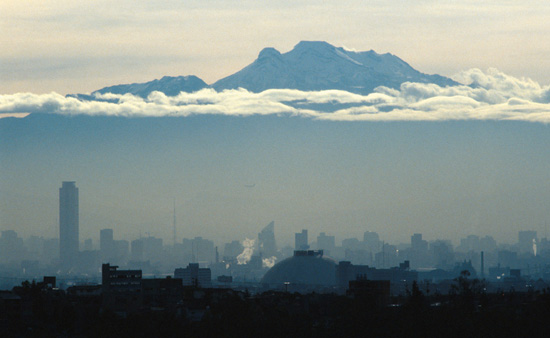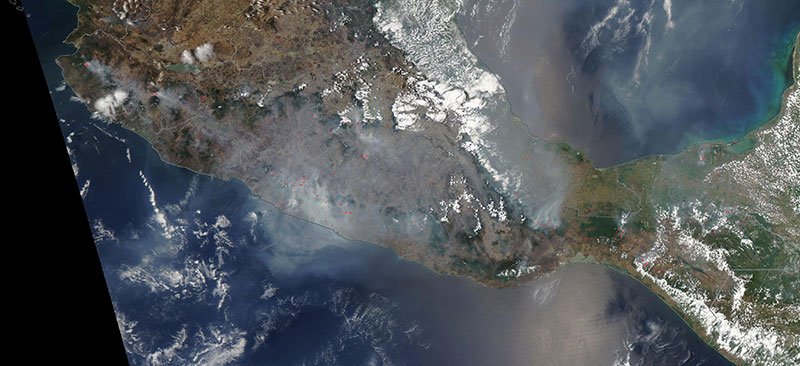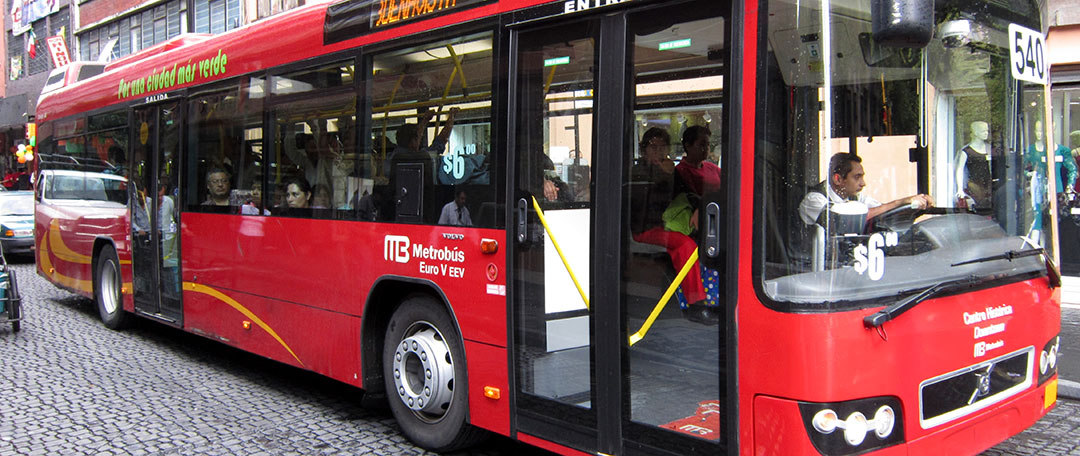
Problems
Air pollution in Mexico City
One of the current environmental hotspots is Mexico City. The situation in this city reached a critical point back in the 20th century and has changed only slightly for the better since then. Besides all the existing environmental problems, such as pollution and lack of fresh water, insufficient access to it and its poor quality; deforestation; soil erosion; desertification; deterioration of agricultural land; pollution, and subsidence of the ground, the most basic and acute is the problem of air pollution in Mexico City. Clean air is not only a luxury but an essential need for everyone. Air pollution is a real problem in Mexico, causing about one in 17 (5.9%) of all deaths in the country. The most dangerous airborne particles are known as PM 2.5 (particles less than 2.5 thousandths of a millimeter across), which can penetrate deep into the lungs. To fully understand the catastrophe and the level of air pollution in Mexico it is enough to remember that living in Mexico City and just breathing the air is equivalent to smoking 2 packs of cigarettes a day. And this is the capital of Mexico with a population of more than 22 million people. In the early 1990s, the environmental situation in the city was so bad that about 1,000 residents died a year for this reason, and more than 35,000 ended up in medical facilities. Several reasons led to this disastrous situation in the city. Mexico City experienced industrialization and urbanization in the 20th century, and the population of the Mexico City Valley metropolitan area, also called Greater Mexico City, grew significantly from 3.1 million people in the 1950s to 14 million in the 1980s. Rapid population growth, an increased workforce, and human activity have led to a dramatic deterioration in air quality. These air pollutants are mostly produced by human activities such as the burning of fossil fuels in power plants and automobile exhausts. The densely populated capital has more than 4 million cars and a large number of industrial plants, resulting in dirty smog enveloping the city. Along with microscopic particles, automobile and industrial emissions of greenhouse gases - carbon monoxide, sulfur dioxide, nitrogen oxides, and ozone - are the main sources of air pollution in Mexico City. Mexico ranks first in Latin America for carbon dioxide emissions, caused by the inefficient use of energy in industry and transportation. Liquid and solid particles from automobile and industrial emissions, fires, soot, and dust are difficult to remove from the atmosphere and have hazardous effects on human health. Mexico city's air pollution problem is also caused by the geographical location of the city. It is surrounded by volcanoes more than 2 km above sea level, plus the hot climate - all these factors lead to increased air pollution. The Mexico City metropolitan area consists of the city proper and the surrounding states and cities in the Mexico City Valley. About 21 million people live at an altitude of 2,240 meters on a plain surrounded by mountains, in the crater of an emission-absorbing ancient volcano. The low oxygen content characteristic of such an altitude reduces the efficiency of car engines, resulting in more pollutants being emitted than elsewhere. Moreover, the warm air over the valley, the so-called "inversion layer," traps pollutants over the metropolis. In addition, the city sits at the bottom of a dried-up lake, during rains some areas of the capital are flooded. The reasons why the air quality in Mexico City is so bad are as follows. × Forest fires × Automobile emissions × Industrial emissions × Surrounding mountains that do not allow pollutants to escape 1. Forest fires. The dense cloud of toxic air in Mexico City's atmosphere is the main result of dozens of forest fires burning in southern Mexico and Central America. Because of the wildfires, pollution levels in the city are above critical levels. There have been long dry and high-temperature seasons recently. This has resulted in wildfires. Because of this, the air quality in the city is getting so bad that local authorities are urging people to stay indoors because the air outside is not safe to breathe. 2. Аutomobile emissions The most important air pollutants in Mexico City are ozone, sulfur dioxide, nitrogen dioxide, hydrocarbons, and carbon monoxide, mainly caused by automobile exhaust. The main culprits are cars that use combustible fuel. About 8 million cars are traveling in the Mexican capital every day, and it is estimated that they produce more than 7,000 tons of pollution in Mexico City every day. This, in turn, creates smog. 3. Industrial emissions Fossil fuels (coal, oil, and natural gas) are the main source of energy in Mexican factories, but the use of fossil fuels causes pollution. When they burn, chemicals and gases are released into the air. These primary pollutants can cause many problems from irritating people's eyes and throats to global warming. Primary pollutants include carbon monoxide, nitrogen oxide, sulfur oxides, and particulate matter such as dust, ashes, etc. In addition to being dangerous on their own, when exposed to the sun, many primary pollutants react photochemically to produce secondary pollutants such as nitrogen dioxide, sulfuric acid, and ozone. 4. Surrounding mountains that prevent pollutants from escaping Mexico City's unique geographical structure allows carbon monoxide pollutants to linger in the air. Mexico City is surrounded by mountains, making it appear to be trapped by high walls of mountains. This makes the city look like a swimming pool, hence the popular phrase, Mexico City's air basin. Because of the structure of the land, the winds cannot carry smog over the surrounding mountains, and as a result, many pollutants, such as carbon monoxide, accumulate over the city.
Gallery
11Timelines
2023
October 27
The concentration of the main pollutant air PM2.5 in Mexico City is currently 5.9 times the WHO annual air quality guideline value. Greenpeace noted: that PM2.5 air pollution in Mexico City is causing an estimated death of 8,200 lives lives since January 1, 2021. It has cost the city's economy around US $4.3 billion so far this year.
February
The Mexico City metropolitan area has activated its first air pollution alert of the year, imposing traffic restrictions and advice against outdoor activities. The Environmental Commission of the Megalopolis (CAMe) said the situation was due to weak southwesterly winds in the center of the country, which concentrated pollutants in the Mexico Valley. The Ajusco Medio monitoring station in Tlalpan, south of the city, recorded a maximum ozone concentration of 155 parts per billion (ppb). Levels below 70 ppb are considered optimal for health, while levels above 100 ppb are harmful. CAMe has activated the first phase of its contingency plan. Under the plan, private cars with certain license plates will not be allowed to circulate in the city as part of Mexico City's longstanding "Hoy No Circula" (no-drive days) air quality program. CAMe also recommends that the people of Mexico City take precautions to protect their health.
2022
April 05
The Environmental Commission of the Megalopolis coordinates environmental programs between the federal and municipal governments in the Valley of Mexico and surrounding metropolitan areas, and has issued five air quality alerts so far in 2022, already topping the four issued the previous year.
2021
March 29
Levels of small particles, known as PM10, reached 581 points in the city’s Iztapalapa borough, on a scale where 100 is considered the highest acceptable level. No formal pollution alert was declared, but the levels were enough to earn a rare “extremely bad” rating from the city’s air-quality monitoring network.
2019
March 15
Officials in Mexico City have declared an environmental emergency after air pollution in the Mexican capital reached levels potentially dangerous to human health. They urged those at particular risk to stay indoors and restricted the number of cars that can be driven in the city on Wednesday.
2018
August 13
Mexico City joins the BreatheLife campaign with a clean air program that benefits over 8.8 million people. The different institutions of Mexico City’s government (CDMX) work in coordination in the application of actions and programs to improve the City's air quality to improve the quality of life and prosperity for the inhabitants under a vision of sustainable development.
2016
March 15
Mexico City's government has advised people to stay indoors and restricted traffic due to air pollution. Ozone levels have been measured at nearly twice the acceptable limit, triggering the first alert in over a decade.
2012
June 06
Ozone and other air pollutants ranked at about the same level as Los Angeles. This improvement in air quality was achieved through the Mexican government's requirement that gasoline is reformulated, that polluting factories be closed or moved, and that drivers be prohibited from using their car one day per week. the use of fuel ethers contributed greatly to an 86% decrease in CO, a 53% decrease in ozone, and a 32% decrease in particulate matter.
2006
June 06
Mexico City was selected as the case study of MILAGRO (Megacity Initiative: Local And Global Research Observation), an international scientific project to investigate the outflow of emissions from a megacity. These field studies have provided comprehensive datasets for updating and improving the emissions inventory, the chemistry, dispersion, and transport processes of the pollutants emitted to the MCMA atmosphere, and their regional and global impacts.
1995
August 13
The city’s government launched an extensive program, named ProAir. It contains several concrete measures to achieve sustainable development in eight areas: reduction of energy consumption, cleaner and more efficient energy across all sectors, promotion of public transport and regulation of fuel consumption, technology shift and emissions control, environmental education and sustainability, culture and citizen participation, green areas and reforestation, institutional capacity building and scientific research, as well as strengthening of health protection.
1993
July 10
The government mandated the replacement of lead-octane additives with MTBE and PEMEX, the state-run petroleum company, replacing underground storage tanks at all of its petrol stations.
1992
April 04
The United Nations named Mexico City " the most polluted city on the planet" and "the most dangerous city for children".
1990
May 15
The Mexican government decided to implement some air quality management programs to reduce emissions. Some of the programs included the removal of lead from gasoline and the implementation of catalytic converters in automobiles, the reduction of sulfur content in diesel transportation fuel, the substitution of fuel oil in industry and power plants with natural gas, reformulation of liquified petroleum gas used for heating and cooking.
